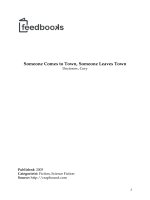- Trang chủ >>
- Mầm non - Tiểu học >>
- Lớp 5
5 4 4 nathaniel comes to town TG
Bạn đang xem bản rút gọn của tài liệu. Xem và tải ngay bản đầy đủ của tài liệu tại đây (117.34 KB, 4 trang )
Nathaniel
Comes to Town
SUMMARY
Drew hates going to school, has
very few friends, and hates lying about how he
feels about school. Then Nathaniel, a boy he
met at the beach the summer before, moves
to town. Nathaniel tries to become friends
with Drew, but Drew is embarrassed by him
and rejects Nathaniel at first. By the end of
the story, their friendship is patched and
Drew feels better about school.
LESSON VOCABULARY
annoyingly
gallantly
jostling
foreboding
humiliation
skeptically
INTRODUCE THE BOOK
INTRODUCE THE TITLE AND AUTHOR
Discuss with
students the title and author of Nathaniel
Comes to Town. Based on the title alone, ask
students what they think the story will be
about. Does the picture on the front cover
give them any clues?
BUILD BACKGROUND Ask students if any of them
have ever had trouble finding friends in school.
What did they do to make new friends? Ask
them if they have ever befriended a new student. Ask them what they look for in a friend.
Have students talk about what it
was like for them to be new students at a
new school. What did they do to try to make
friends? Was English a barrier, or were they
able to communicate?
PREVIEW
Encourage students to look at the
chapter headings and illustrations to try to
predict what will happen in this book.
5.4.4
GENERALIZE
GRAPHIC ORGANIZERS
READ THE BOOK
SET PURPOSE
Have students set a purpose for
reading Nathaniel Comes to Town. Students
may want to pick a character to follow, such
as Drew or Nathaniel. Have the students
follow what happens to the character and why.
They may want to take notes as they read.
STRATEGY SUPPORT: GRAPHIC ORGANIZERS
Remind students that graphic organizers are
story maps, webs, graphs, charts, time lines,
and other devices that help them understand
relationships among events, ideas, and words.
Give students practice in using a graphic organizer by having them make a cause-and-effect
chart to track what happens and why it happens as they read Nathaniel Comes to Town.
Start students off by asking: Why does Drew
have a heavy feeling in his stomach every
morning? (He doesn’t want to go to school.)
COMPREHENSION QUESTIONS
PAGES 4–6
List all of the reasons you can find
in the first chapter of the story that Drew
doesn’t like school. (no friends, former friends,
feeling sick)
PAGE 8 What did Drew think of Nathaniel
after spending time with him at the beach?
(He thought he was annoyingly smart.)
PAGES 17–18 When Nathaniel has lunch with
Soraya instead of Drew, what emotion
does Drew feel? (envy)
PAGE 21
What happens when Julie
tries to make dinner for their guests?
(She sets off the fire alarm.)
PAGES 24–25
Why was Drew embarrassed
by his purple basketball? (Jeff made fun of
it, which led to the end of their friendship.)
PAGES 24–27
What happens between Drew and
Nathaniel while they are playing basketball?
(They become friends again.)
84
Nathaniel Comes to Town
16924_LRD_TG_084-085 84
6/16/06 12:17:59 PM
REVISIT THE BOOK
READER RESPONSE
1. It is hard to make friends and easy to
feel lost. Moving to a new school can be
difficult.
2. Possible responses: Characters—Drew,
Nathaniel; Setting—school bus, home,
basketball court; Problem—Drew hates
school because he has few friends; Event
1—Nathaniel moves into the neighborhood;
Event 2—Drew and Nathaniel become
friends; Solution—Friendship changes
Drew’s outlook on school.
3. Possible responses: skeptically: My mother
looked at me skeptically when I offered to
help; offended: I felt offended by my sister’s
negative comment; demoted: I was demoted
to junior varsity; cavities: I had two cavities
filled.
4. Possible responses: Nathaniel makes
friends by actively trying and not being easily defeated. Drew takes longer to make
friends.
Remind students that
a character is the person who does the action
in the story. Review with students that you
can use the details in the story to tell many
things about what kind of person a character
is. Ask the students to think about how Drew
changes as a character. Ask: Does this relate
to the theme of the story?
EXTEND UNDERSTANDING
RESPONSE OPTIONS
Have students think back to their
first day in grammar school. Have them write
about how they felt. How did they try to make
friends? Ask them to write about how they
made friends.
WRITING
SOCIAL STUDIES
CONNECTION
Have students read
about the Three Famous
Failures on page 32. Have them
choose one of the three and research
that person on the Internet or in the library.
Skill Work
TEACH/REVIEW VOCABULARY
Review the vocabulary words. Then play
“Vocabulary Master” with students. Give
them three different definitions for each
vocabulary word, including one that is fantastical or silly. Have them select the correct
definition and use the word in a sentence.
TARGET SKILL AND STRATEGY
GENERALIZE Tell students: “Sometimes
when you read, you are given ideas about
things or people, and you can make a statement about all of them together. This statement is called a generalization. Look for
clue words, such as most, always, all, and
never. Valid generalizations are accurate.
Faulty generalizations are not accurate.”Tell
students that identifying faulty generalizations can help them tell whether an author
or character is biased. Have students make
their own generalization by stating how the
kids at school feel about Drew at the beginning of the story. After reading, ask: Is your
generalization still valid?
Remind students
that graphic organizers help to arrange information in a visual way. Have students make
a two-column chart and list three generalizations made on page 4 in the first column.
(Adults always ask Drew the same question.
All of the other kids talk and laugh. No one
talks to Drew except the teacher.) Remind
students that the generalizations are from
Drew’s point of view. In the second column,
students should explain why they think each
generalization is most likely valid or faulty.
GRAPHIC ORGANIZERS
ADDITIONAL SKILL INSTRUCTION
Remind students that the
theme of a story is the underlying meaning
of a story and a story may have different
themes. Remind them that the plot is the
organized pattern of events. As they read,
have students follow the plot through beginning, middle and end. Have them think
about the climax of the story. What do they
think the theme of the story is, and how
does the climax relate to the theme?
THEME AND PLOT
Nathaniel Comes to Town
16924_LRD_TG_084-085 85
85
10/21/05 10:23:47 AM
Name
Nathaniel Comes to Town
Generalize
• A generalization is a broad statement or rule that applies to many examples. A generalization is
made after thinking about a number of examples or facts and what they have in common.
Directions What are some of the difficulties faced by Nathaniel as a new student? What can you
generalize about the difficulties that all new students face?
1-5.
© Pearson Education 5
Directions Based on Drew’s experiences, what can you generalize about how difficult it is to help a
new student find his way?
6-10.
86
16924_LRD_TG_086-087 1
10/20/05 2:44:41 PM
Nathaniel Comes to Town
Name
Vocabulary
Directions Fill in the blank with the word from the box that fits best.
Check the Words You Know
annoyingly
gallantly
jostling
foreboding
humiliation
skeptically
1. Drew viewed going to school with
2. Nathaniel
and dread.
tried to make friends at his new school.
3. The color of Drew’s basketball caused him
4. In gym class, Nathaniel tried
5. Drew’s sister liked to tease him
6. Drew reacted
.
for the ball.
.
to his teacher’s cheerful greeting.
© Pearson Education 5
Directions Write a brief paragraph discussing Nathaniel’s first day at school, using as many
vocabulary words as possible.
87
16924_LRD_TG_086-087 2
3/20/06 8:47:28 AM









